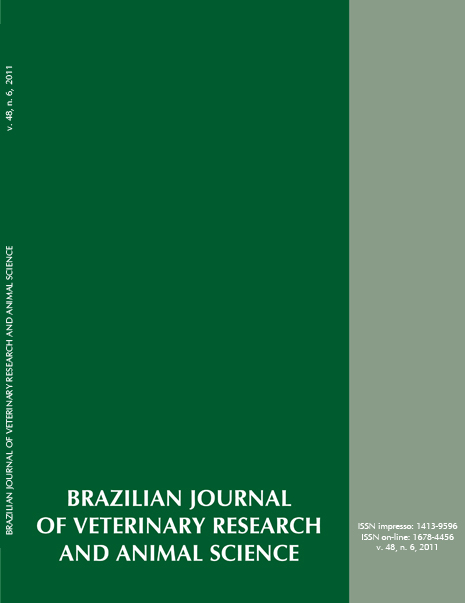Comparison of the efficacy of two extraction methods for determination of lipid fatty acids of sheep semen by high performance liquid chromatography
DOI:
https://doi.org/10.11606/S1413-95962011000600007Keywords:
Semen, Sheep, Lipid profile, HPLC, ExtractionAbstract
The sheep industry for wool, milk and meat production is of increasing importance and new technologies for assessment of semen are in course for the elucidation of male infertility causes. It is well known that damage to the sperm membrane decreases semen quality. Considering that sperm membranes are composed by a phospholipid bilayer, and that lipid peroxidation is a major cause of cell damage, studieson the lipid components of semen are relevant. Lipid peroxidation is a consequence of the reaction between lipids and reactive oxygen species. This event may be reduced in the presence of antioxidants in semen. Semen was collected with an artificial vagina and, after sperm evaluation, samples were centrifuged to separate the sample into two fractions: seminal plasma and spermatozoa pellet. Both had their lipids extracted by two different methods based on Folch, Less& Stanley method modified, using chloroform e methanol as solvents. After the extraction, some esterified fatty acids were qualified and quantified for the sensitivity and specificity to the high performance liquid chromatography in order to determine the most efficient extraction technique in quantitative and qualitative aspects. Statistical analysis was performed using SAS software for Windows. The predominant saturated fatty acid in sperm under these experimental conditions was the myristic and the most abundant insaturated fatty acid in both extractions was DHA. In seminal plasma, in both methods, the prevailing fatty acid is the saturated palmitic and the unsaturated oleic. Among the methods evaluated, we obtained the best results of identification and quantification of fatty acids in Method 1.Downloads
Download data is not yet available.
Downloads
Published
2011-12-01
Issue
Section
UNDEFINIED
License
The journal content is authorized under the Creative Commons BY-NC-SA license (summary of the license: https://
How to Cite
1.
Cardoso PBS, Nichi M, Zogno MA, Fujiwara H, Barnabe VH, Barnabe RC. Comparison of the efficacy of two extraction methods for determination of lipid fatty acids of sheep semen by high performance liquid chromatography. Braz. J. Vet. Res. Anim. Sci. [Internet]. 2011 Dec. 1 [cited 2024 Apr. 18];48(6):486-94. Available from: https://revistas.usp.br/bjvras/article/view/34356





